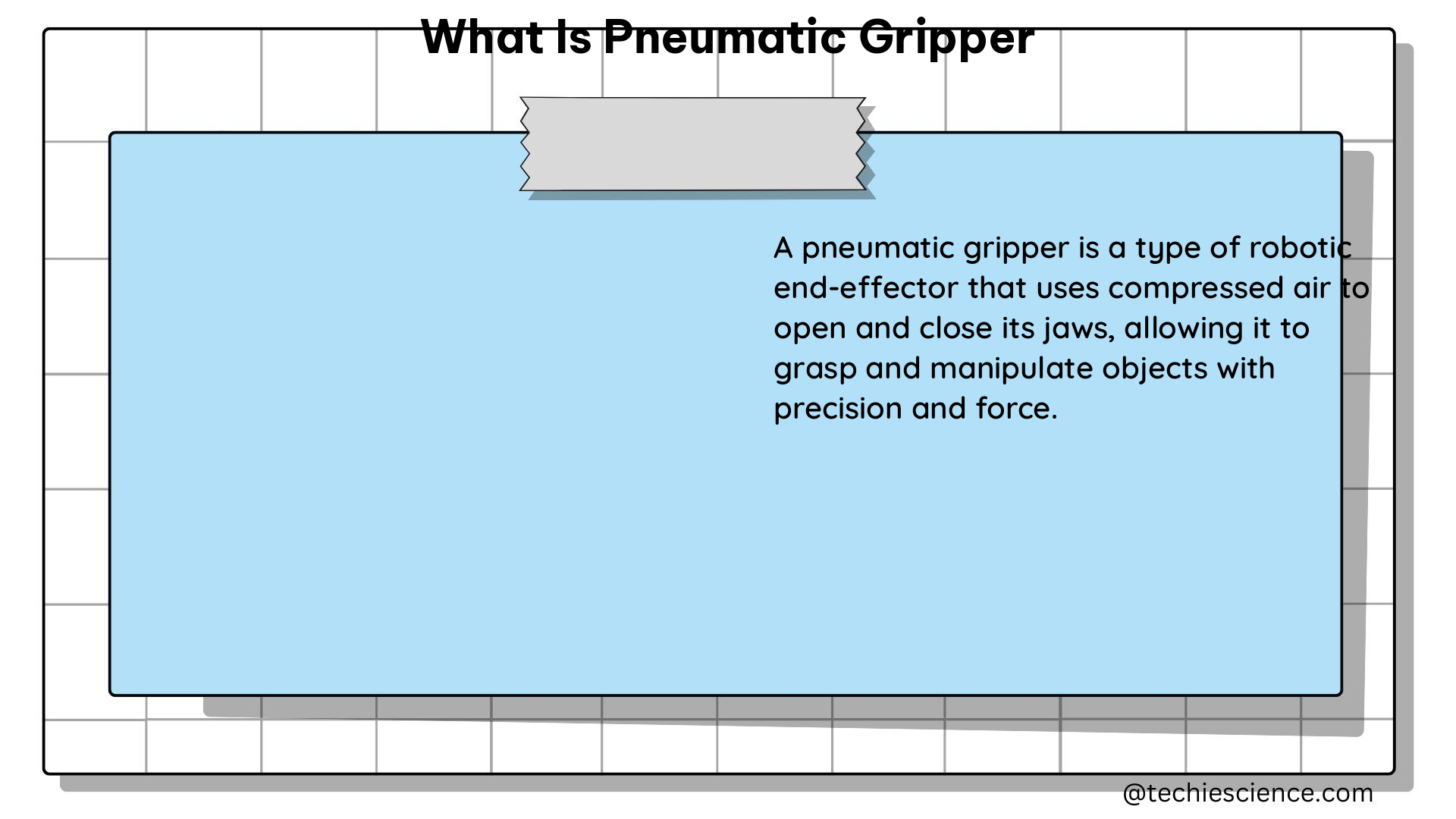A pneumatic gripper is a type of pneumatic actuator gripping solution that uses compressed air to operate gripper jaws or fingers that grasp an object. These grippers are capable of picking up, placing, holding, and releasing objects while an action is being executed. The gripping force of a pneumatic gripper is determined by various factors such as the effective gripping force, workpiece weight, air pressure, configuration of the workpiece, type of gripper, and the operating environment. Pneumatic grippers are commonly used in industries such as aerospace, automotive, food and packaging, and consumer goods.
Understanding the Gripping Force of Pneumatic Grippers
The gripping force of a pneumatic gripper can be calculated using the formula:
F = (P x A) / 2
Where:
– F is the gripping force (in Newtons)
– P is the air pressure (in Pascals)
– A is the effective area of the gripper jaws or fingers (in square meters)
For example, if the air pressure is 100 psi (689,476 Pa) and the effective area of the gripper jaws or fingers is 0.0013 m^2, the gripping force would be:
F = (689,476 Pa x 0.0013 m^2) / 2 = 448 N
The workpiece weight must be considered as the gripping force must be able to support the weight of the workpiece during the operation. The air pressure should also be considered as it has a direct effect on the gripping force and influences the gripper sizing.
Gripper Configuration and Selection

The configuration of the workpiece will help determine whether 2 or 3 finger grippers can be used. 2 finger grippers are commonly used and can be used for a wide variety of objects, while 3 finger grippers are suitable for round or cylindrical objects.
The type of gripper may have external or internal grip depending upon the workpiece. Pneumatic grippers should be selected based on the operating environment, as grippers designed for clean environments may fail in harsh environments.
Sensor Integration and Repeatability
In addition to the gripping force and configuration, sensors can be installed alongside pneumatic grippers to monitor and control the operating position of the fingers. Sensor switches or proximity sensors can be installed on the pneumatic grippers to detect the open or closed position of the fingers. Proximity sensors can detect the proximity by sensing the object and provide the information back to the controller.
Repeatability is also an important factor to consider when selecting a pneumatic gripper. Repeatability is the measure for maximum position accuracy that the gripper can achieve. The pneumatic grippers can have different repeatability based on the number of fingers and speed of operation. So, the repeatability must be determined based on the precision required for the application.
Technical Specifications of Pneumatic Grippers
Pneumatic grippers can have varying specifications based on the manufacturer and model. For example:
Destaco Pneumatic Automation Grippers:
– Gripping force range: 2.25 to 11,023 N
– Stroke range: 0 to 50.8 mm
– Air pressure range: 4 to 10 bar
Goudsmit Pneumatic Magnetic Grippers:
– Lifting power range: up to 110 kg
– Magnetic field range: 0 to 120°C
– Gripper size range: 25 to 100 mm
These technical specifications can help you select the appropriate pneumatic gripper for your application based on the required gripping force, stroke, air pressure, and other factors.
Advantages of Pneumatic Grippers
Pneumatic grippers offer several advantages over other types of gripping solutions:
- High Gripping Force: Pneumatic grippers can generate high gripping forces, making them suitable for handling heavy or bulky objects.
- Fast Response Time: Pneumatic grippers can respond quickly to control signals, enabling fast pick-and-place operations.
- Simplicity and Reliability: Pneumatic grippers have a simple design and are generally more reliable than other types of grippers.
- Suitability for Harsh Environments: Pneumatic grippers are well-suited for use in harsh environments, such as those with high temperatures, humidity, or the presence of dust or debris.
- Cost-Effectiveness: Pneumatic grippers are generally more cost-effective than other types of gripping solutions, making them a popular choice for industrial applications.
Applications of Pneumatic Grippers
Pneumatic grippers are widely used in various industries, including:
- Aerospace: Handling and assembling aircraft components, such as wings, fuselage, and engines.
- Automotive: Handling and assembling car parts, such as doors, hoods, and engines.
- Food and Packaging: Handling and packaging food products, such as bottles, cans, and boxes.
- Consumer Goods: Handling and assembling consumer products, such as electronics, toys, and household appliances.
- Robotics: Integrating pneumatic grippers into robotic systems for pick-and-place operations.
Conclusion
Pneumatic grippers are a versatile and widely used type of gripping solution in various industries. By understanding the factors that influence the gripping force, the configuration and selection of grippers, the integration of sensors, and the technical specifications, you can effectively select and utilize pneumatic grippers in your science and engineering applications.
References
- Grasping Profile Control of a Soft Pneumatic Robotic Gripper for Delicate Gripping. (2023). Robotics, 12(4), 107.
- Pneumatic Automation Grippers (Family). (n.d.). Destaco.
- Fundamentals of Pneumatic Grippers for Industrial Applications. (2022, April 13).
- Pneumatic Gripper – How They Work. (2020, January 4). Tameson.com.
- Pneumatic magnetic grippers. (n.d.). Goudsmitmagnets.com.

I have a background in Aerospace Engineering, currently working towards the application of Robotics in the Defense and the Space Science Industry. I am a continuous learner and my passion for creative arts keeps me inclined towards designing novel engineering concepts.
With robots substituting almost all human actions in the future, I like to bring to my readers the foundational aspects of the subject in an easy yet informative manner. I also like to keep updated with the advancements in the aerospace industry simultaneously.